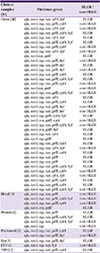1. Fisher K, Phillips C. The ecology, epidemiology and virulence of Enterococcus
. Microbiology. 2009; 155:1749–1757.
2. Guerrero-Ramos E, Molina-González D, Blanco-Morán S, Igrejas G, Poeta P, Alonso-Calleja C, Capita R. Prevalence, antimicrobial resistance, and genotypic characterization of vancomycin-resistant enterococci in meat preparations. J Food Prot. 2016; 79:748–756.

3. Emaneini M, Hosseinkhani F, Jabalameli F, Nasiri MJ, Dadashi M, Pouriran R, Beigverdi R. Prevalence of vancomycin-resistant
Enterococcus in Iran: a systematic review and meta-analysis. J Clin Microbiol Infect Dis. 2016; 35:1387–1392.

4. Heidari H, Emaneini M, Dabiri H, Jabalameli F. Virulence factors, antimicrobial resistance pattern and molecular analysis of Enterococcal strains isolated from burn patients. Microb Pathog. 2016; 90:93–97.

5. Barbosa-Ribeiro M, De-Jesus-Soares A, Zaia AA, Ferraz CC, Almeida JF, Gomes BP. Antimicrobial susceptibility and characterization of virulence genes of
Enterococcus faecalis isolates from teeth with failure of the endodontic treatment. J Endod. 2016; 42:1022–1028.

6. Strateva T, Atanasova D, Savov E, Petrova G, Mitov I. Incidence of virulence determinants in clinical
Enterococcus faecalis and
Enterococcus faecium isolates collected in Bulgaria. Braz J Infect Dis. 2016; 20:127–133.

7. Singh KV, La Rosa SL, Somarajan SR, Roh JH, Murray BE. The fibronectin-binding protein EfbA contributes to pathogenesis and protects against infective endocarditis caused by
Enterococcus faecalis
. Infect Immun. 2015; 83:4487–4494.

8. Choi JM, Woo GJ. Molecular characterization of high-level gentamicin-resistant
Enterococcus faecalis from chicken meat in Korea. Int J Food Microbiol. 2013; 165:1–6.

9. Niu H, Yu H, Hu T, Tian G, Zhang L, Guo X, Hu H, Wang Z. The prevalence of aminoglycoside-modifying enzyme and virulence genes among enterococci with high-level aminoglycoside resistance in Inner Mongolia, China. Braz J Microbiol. 2016; 47:691–696.

10. Ceci M, Delpech G, Sparo M, Mezzina V, Sánchez Bruni S, Baldaccini B. Clinical and microbiological features of bacteremia caused by
Enterococcus faecalis
. J Infect Dev Ctries. 2015; 9:1195–1203.

11. Al-Talib H, Zuraina N, Kamarudin B, Yean CY. Genotypic variations of virulent genes in
Enterococcus faecium and
Enterococcus faecalis isolated from three hospitals in Malaysia. Adv Clin Exp Med. 2015; 24:121–127.

12. Honarm H, Falah Ghavidel M, Nikokar I, Rahbar Taromsari M. Evaluation of a PCR assay to detect Enterococcus faecalis in blood and determine glycopeptidesresistance genes: van A and van B. Iran J Med Sci. 2012; 37:194–199.
13. Kaveh M, Bazargani A, Ramzi M, Sedigh Ebrahim-Saraie H, Heidari H. Colonization rate and risk factors of vancomycin resistant enterococci among patients received hematopoietic stem cell transplantation in Shiraz, Southern Iran. Int J Organ Transplant Med. 2016; 7:197–205.
14. Dutka-Malen S, Evers S, Courvalin P. Detection of glycopeptide resistance genotypes and identification to the species level of clinically relevant enterococci by PCR. J Clin Microbiol. 1995; 33:1434.

15. Clinical and Labratory Standard Institute (CLSI). Performance standards for antimicrobial susceptibility testing. 25th informational supplement. Wayne, PA: CLSI;2015. p. M100-S23.
16. Mohammadi F, Ghafourian S, Mohebi R, Taherikalani M, Pakzad I, Valadbeigi H, Hatami V, Sadeghifard N.
Enterococcus faecalis as multidrug resistance strains in clinical isolates in Imam Reza hospital in Kermanshah, Iran. Br J Biomed Sci. 2015; 72:182–184.

17. Karimzadeh I, Mirzaee M, Sadeghimanesh N, Sagheb MM. Antimicrobial resistance pattern of Gram-positive bacteria during three consecutive years at the nephrology ward of a tertiary referral hospital in Shiraz, Southwest Iran. J Res Pharm Pract. 2016; 5:238–247.

18. Filipová M, Bujdákova H, Drahovská H, Lisková A, Hanzen J. Occurrence of aminoglycoside-modifying-enzyme genes
aac(6′)-aph(2"), aph(3′), ant(4′) and ant(6) in clinical isolates of
Enterococcus faecalis resistant to high-level of gentamicin and amikacin. Folia Microbiol (Praha). 2006; 51:57–61.

19. Gaglio R, Couto N, Marques C, de Fatima Silva Lopes M, Moschetti G, Pomba C, Settanni L. Evaluation of antimicrobial resistance and virulence of enterococci from equipment surfaces, raw materials, and traditional cheeses. Int J Food Microbiol. 2016; 236:107–114.

20. Gulhan T, Boynukara B, Ciftci A, Sogut MU, Findik A. Characterization of Enterococcus faecalis isolates originating from different sources for their virulence factors and genes, antibiotic resistance patterns, genotypes and biofilm production. Iran J Vet Res. 2015; 16:261–266.
21. Hällgren A, Claesson C, Saeedi B, Monstein HJ, Hanberger H, Nilsson LE. Molecular detection of aggregation substance, enterococcal surface protein, and cytolysin genes and in vitro adhesion to urinary catheters of
Enterococcus faecalis and
E. faecium of clinical origin. Int J Med Microbiol. 2009; 299:323–332.

22. Arias CA, Murray BE. The rise of the
Enterococcus: beyond vancomycin resistance. Nat Rev Microbiol. 2012; 10:266–278.

23. Kafil HS, Mobarez AM. Spread of enterococcal surface protein in antibiotic resistant
Enterococcus faecium and
Enterococcus faecalis isolates from urinary tract infections. Open Microbiol J. 2015; 9:14–17.

24. Ferguson DM, Talavera GN, Hernández LA, Weisberg SB, Ambrose RF, Jay JA. Virulence genes among Enterococcus faecalis and Enterococcus faecium isolated from coastal beaches and human and nonhuman sources in Southern California and Puerto Rico. J Pathog. 2016; 2016:3437214.
25. Molale LG, Bezuidenhout CC. Antibiotic resistance, efflux pump genes and virulence determinants in
Enterococcus spp. from surface water systems. Environ Sci Pollut Res Int. 2016; 23:21501–21510.

26. Guerrero-Ramos E, Cordero J, Molina-González D, Poeta P, Igrejas G, Alonso-Calleja C, Capita R. Antimicrobial resistance and virulence genes in enterococci from wild game meat in Spain. Food Microbiol. 2016; 53:156–164.

27. Yang JX, Li T, Ning YZ, Shao DH, Liu J, Wang SQ, Liang GW. Molecular characterization of resistance, virulence and clonality in vancomycin-resistant
Enterococcus faecium and
Enterococcus faecalis: a hospital-based study in Beijing, China. Infect Genet Evol. 2015; 33:253–260.

28. Arbabi L, Boustanshenas M, Rahbar M, Owlia P, Adabi M, Koohi SR, Afshar M, Fathizadeh S, Majidpour A, Talebi-Taher M. Antibiotic susceptibility pattern and virulence genes in Enterococcus spp. isolated from clinical samples of Milad hospital of Tehran, Iran. Arch Clin Infect Dis. 2016; 11:e36260.







 PDF
PDF ePub
ePub Citation
Citation Print
Print


 XML Download
XML Download